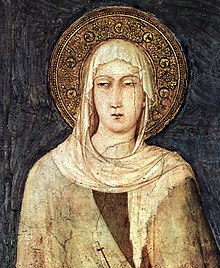Clare of Assisi
Saint Claire of Assisi | |
|---|---|
 Simone Martini, detail depicting Saint Clare from a fresco (1312–20) in the Lower basilica of San Francesco, Assisi | |
| Confessor | |
| Born | July 16, 1194 Assisi, Italy |
| Died | August 11, 1253 Assisi, Italy |
| Venerated in | Roman Catholic Church, Anglican Communion, Lutheran Church |
| Canonized | September 26, 1255 by Pope Alexander IV |
| Major shrine | Basilica of St. Clare, Assisi |
| Feast | August 11 (alternates: August 12, September 23, October 3) |
| Attributes | monstrance, pyx, lamp, habit of the Poor Clares |
| Patronage | clairvoyance, eyes, eye disease, goldsmith, laundry, embrodiers, gilders, gold, good weather, needleworkers, Santa Clara Pueblo, telephones, telegraphs, television |
Saint Clare of Assisi, born Chiara Offreduccio (July 16, 1194 – August 11, 1253) was an Italian saint, one of the first followers of Francis of Assisi and founded the Order of Poor Ladies to organize the women who chose to embrace monastic life in the Franciscan vision.
Biography
Clare was born in Assisi, Umbria, as the eldest daughter of Favorino Scifi, Count of Sasso-Rosso and his wife Ortolana. Ortolana was a very devout woman who had undertaken pilgrimages to Rome, Santiago de Compostela and the Holy Land. Later on in her life, Ortolana entered Chiara's monastery.[1] In 1210, Clare heard Francis preaching in the streets of Assisi about his new mendicant order (then newly-approved by Pope Innocent III) and was moved by his words. On March 20, 1212, Clare's parents had decided she would marry a wealthy young man. In desperation Clare left her home and sought refuge in St. Francis, who received her into religious life. She lived at the Church of San Damiano where she founded an order of nuns. She had their hair cut short and put on rough tunics to indicate her acceptance of the vows of poverty, chastity and obedience, and stayed first with a nearby monastery of Benedictine nuns, San Paolo delle Abadesse and then into the community of Sant'Angelo in Panza on Mont Subasio. Her sister Agnes of Assisi also left her parents and followed her to Sant'Angelo. [2] Later, Clare and Agnes moved to San Damiano, where they founded the Order of Poor Ladies (also then known as the Order of San Damiano).
Unlike the Franciscan order, whose members moved around the country to preach, Saint Clare's sisters lived in enclosure, since an itinerant life was hardly conceivable at the time for women. Their life consisted of manual labour [3] and prayer.
After a time when the order was directed by Francis himself [4], in 1216, Clare accepted the role of abbess at San Damiano which gave her order greater autonomy than the title of a prioress, who had to follow the orders of a priest heading the community. [5] As abbess, she defended her order from the attempts of prelates to impose a rule on them that more closely resembled the Rule of St Benedict than Francis' stricter vows. Clare also played a significant role in encouraging and aiding Francis, whom she saw as a spiritual father figure: she took care of him during his illnesses at the end of his life, until his death in 1226.
After Francis's death, Clare continued to promote the growth of her order, writing letters to abbesses in other parts of Europe and thwarting every attempt by each successive Pope to impose a Rule on her order which watered down the radical commitment to corporate poverty she had originally embraced. She did this despite the fact that she had endured a long period of poor health until her death.
She is known for her loyalty to Saint Francis, so much so that she was sometimes titled alter Franciscus, another Francis. [6]
On August 9, 1253, the Papal bull Solet annure of Pope Innocent IV confirmed that Clare's Rule would serve as the governing rule for the Order of Poor Ladies. Two days later, on August 11, Clare died at the age of 59.
On August 15, 1255, Pope Alexander IV canonized Clare as Saint Clare of Assisi. In 1263, Pope Urban IV officially changed the name of the Order of Poor Ladies to the Order of Saint Clare.

On February 17, 1958, Pope Pius XII designated her as the patron saint of television, on the basis that, when she was too ill to attend a Mass, she had been miraculously able to see and hear it on the wall of her room. The Eternal Word Television Network (EWTN) was founded by Mother Angelica, a Poor Clare.
In art, she is shown carrying a monstrance or pyx, in commemoration of the time when she warded away attackers at the gates of her convent by raising the Blessed Sacrament over the wall.
Lake Saint Clair and the Saint Clair River in the Great Lakes region of North America were named on her feast day August 12, 1679. Since 1970, her feast day has been the date of her death August 11 in the revised liturgical calendar. Although her body is no longer incorrupt, her skeleton was found to be in a perfect state of preservation and is displayed in Assisi.
External links
- Bartoli, Marco. Chiara d'Assisi. Rome 1989: Instituto Storico dei Cappucini.
- St. Clare of Assisi in Catholic Encyclopedia
- The pear-tree of St. Clare in the Convent of the Poor Clares of Perpetual Adoration in Bautzen
- St. Clare of Assisi
- Musical Theatre about St. Francis and St. Clare of Assisi
- Saint Clare of Assisi in Patron Saints Index
